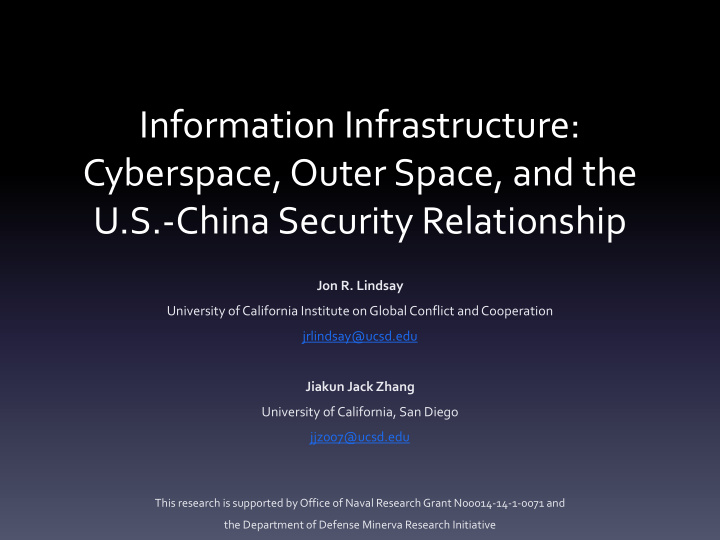



Information Infrastructure: Cyberspace, Outer Space, and the U.S.-China Security Relationship Jon R. Lindsay University of California Institute on Global Conflict and Cooperation jrlindsay@ucsd.edu Jiakun Jack Zhang University of California, San Diego jjz007@ucsd.edu This research is supported by Office of Naval Research Grant N00014-14-1-0071 and the Department of Defense Minerva Research Initiative
Cross Domain Deterrence and China • Cross Domain Deterrence (CDD) extends classical deterrence by investigating how threats in one domain can be countered by unlike capabilities in another • Domains: land, air, sea, space, and cyber • Pentagon interest motivated by the rise of China’s A2/AD capabilities • China’s A2/AD arsenal includes naval, missile, and air force modernizations with particular emphasis on space and cyber systems to extend command and control and deny it to an adversary • This paper investigates the role of cyber and space domains in a potential conflict against China
Space and cyber war • “The next Pearl Harbor could very well be a cyber - attack” – Leon Panetta, Secretary of Defense • “Space is foundational capability for all military operations, yet we don’t really plan for anything but success…the heavens aren’t the ‘peaceful sanctuary’ they once were” – William Shelton, Air Force Space Command • “Theoretically speaking, it is impossible for an operating information system to completely protect itself from enemy’s infiltration” – The Science of Campaigns
Outline • Theory becomes vital in the absence of precedent • We apply theories of interdependence to the space and cyber domains • 1) Information infrastructure: space and cyber systems derive value from their ability to gather, transmit, and process information • 2) Military-technical logic of vulnerability: Asymmetry, offense dominance, instability • 3) Political-economic logic of restraint: Opportunity costs, credible signals, transforming preferences • “Looking at today’s cyber domain, interdependence and vulnerability are twin facts that are likely to persist” (Nye 2013)
Information Infrastructure • Space and cyber systems involve very different technologies but serve the same political-economic purpose • Not valuable in and of itself, they are not low-cost alternatives to traditional power projection • Space and cyber capabilities are information infrastructure, they are institutions as well as technology • Their value stem from their control relationship to other activity • Their vulnerability is predicated on networked systems, therefore mutually constituted and cross-domain in nature • Force multipliers in traditional domains, which in turn support political objectives
Military-Technical Logic of Vulnerability • Existing security literature has focused on vulnerability (Mulvenon 2009, Blasko 2011, Pollpeter 2012, Kello 2013, Junio 2013, Gompert and Libicki 2014) • Asymmetric attack – vulnerability of control systems • Offense dominance – offense easier than defense • Crisis instability – ‘use it or lose it’ • Tactical and operational levels, space and cyber systems can be destabilizing
Institutions and Interdependence • Commerce is a more appropriate analogy • Exchange based on institutions (common protocols), accept mutual vulnerability, enhance existing capabilities • Invulnerability in cyber and space come at the expense of advantages in the traditional domains • This vulnerability creates the dynamics for liberal peace: constrain, inform, transform (Kastner 2009) • Information infrastructure is built upon cooperation, thus makes room for optimism for future dynamics in cyber and space
Opportunity Costs • Information infrastructure is not only useful for C4ISR but also foundational to global capitalism • Conflict in outer space and cyber space would generate opportunity costs • Escalations will be constrained by state desire to avoid collateral damage for multi-use infrastructures • Externalities in space are particularly salient because of the long term impact of space debris
Breakdown of Satellites by Type Civil 31% Commercial 32% Military 28% Military/ Commercial 9% Source: UCS Satellite Database
Comparative Breakdown of Satellites of the USA and China USA China 273 119 68 60 38 34 10 0 Civil Commercial Military Military/Commercial
Credible Signals • Cyber and space assets help detect costly signals (ex. Mobilization) made in other domains, helping reduce bargaining failure over uncertainty about capabilities • Robust and reliable C4ISR allows states to differentiate signals from cheap talk and prevents inadvertent escalation • Live and let live dynamic in US and USSR space race (ex. Outer Space Treaty) • Serious attempt to degrade C4ISR or C2 would be interpreted as a very strong signal of hostile intention (equal to nuclear war) • This danger should lead to restraint and caution rather than escalation
Transformed Preferences • Preferences of decision makers are not fixed and cooperation can be socialized • More likely in space and cyber than traditional domains because they are already highly institutionalization • The development of norms and rules for cyber and space governance are prominent in policy writing • Lawfare more likely than warfare: “It is necessary to proactively participate in the formulation of outer space laws, and strive to establish the laws that are advantageous to us, and disadvantageous to the enemy” – Course of Study of Space Operations
Breakdown of Satellites by Nationality China 16% Russia 16% USA 66% ESA 2%
Through a Glass, Half Full • Room for optimism in U.S.-China relations in new domains • China is developing increasing space and cyber capabilities, but this is not necessarily a threat to stability • Interdependencies do not eliminate competition, friction will persist but prevent high intensity escalation is no more likely • Important not to conflate low intensity friction with high intensity conflict
Conclusion • Weigh in the policy debate on space and cyber to present the case for optimism • Introduce the logic of interdependence to another realm • Interdependence both enables and constrains the military utility of information infrastructure • At tactical and operational levels, space and cyber systems can be destabilizing • Viewed as institutions, the political economic incentives for restraint also exist • Importance of norms and conventions
Thank you
Recommend
More recommend